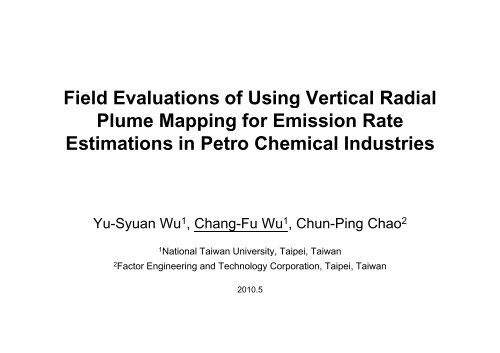Field Evaluations of Using Vertical Radial Plume Mapping for ...
Field Evaluations of Using Vertical Radial Plume Mapping for ...
Field Evaluations of Using Vertical Radial Plume Mapping for ...
Create successful ePaper yourself
Turn your PDF publications into a flip-book with our unique Google optimized e-Paper software.
<strong>Field</strong> <strong>Evaluations</strong> <strong>of</strong> <strong>Using</strong> <strong>Vertical</strong> <strong>Radial</strong><br />
<strong>Plume</strong> <strong>Mapping</strong> <strong>for</strong> Emission Rate<br />
Estimations i in Petro Chemical Industries<br />
Yu-Syuan Wu 1 , Chang-Fu Wu 1 , Chun-Ping Chao 2<br />
1<br />
National Taiwan University, Taipei, Taiwan<br />
2<br />
Factor Engineering and Technology Corporation, Taipei, Taiwan<br />
2010.5
Outline<br />
• Introduction<br />
– VRPM<br />
• Methods<br />
– <strong>Field</strong> studies (industrial complex)<br />
– Algorithms <strong>for</strong> flux estimation<br />
• Results<br />
• Discussions and Conclusion
Introduction
Introduction<br />
• Air pollutants vs. health effects<br />
• Source Strength<br />
– Emission rate / Flux<br />
– Air quality control<br />
– Environmental Impact Assessment<br />
– Dispersion models<br />
VOCs<br />
4
• Point sources<br />
Introduction<br />
– e.g. stacks, vents, …<br />
– in-stack monitors (concentration, ti flow rate)<br />
•Fugitive emissions<br />
– e.g. leaking valves, fittings, …<br />
– Emission i factors<br />
• U.S. EPA’s Method AP-42 Compilation <strong>of</strong> Air<br />
Pollutant Emission Factors<br />
• Large uncertainty / not plant specific / no temporal<br />
resolution
• Fugitive emissions<br />
Introduction<br />
– US EPA: OTM-10 (2006)<br />
• Optical Remote Sensing <strong>for</strong> Emission Characterization from<br />
Non-point Sources<br />
– OP-FTIR<br />
Source/<br />
Detector<br />
Air pollution<br />
Retroreflector
Introduction<br />
• <strong>Vertical</strong> <strong>Radial</strong> <strong>Plume</strong> <strong>Mapping</strong> (VRPM)<br />
(OTM-10)
Objective<br />
• Evaluate the feasibility <strong>of</strong> implementing<br />
VRPM in complicated petro-chemical<br />
industries<br />
– Two field campaigns<br />
– Tracer gases were released to verify the<br />
accuracy <strong>of</strong> the estimation results
Methods
Methods Acrylonitrile Butadiene Styrene<br />
Ethylene-Vinyl Acetate<br />
ARRANGEMENT<br />
Campaign 1<br />
Campaign 2<br />
Time 10 th to13 th Feb. 22 nd to 27 th May.<br />
Target process ABS process EVA process<br />
Size <strong>of</strong> target process L:55m, W:26m, H:8m L:108m,W:58m, H:15m<br />
Heights <strong>of</strong> retroreflectors 1.5m, 5m, 12m 8.5m, 16.4m, 24.4m<br />
Lengths <strong>of</strong> downwind beam<br />
paths<br />
~116 m ~184 m<br />
Tracer gas flow rate 0.056 g/s 0.092 g/s<br />
Heights <strong>of</strong> meteorological<br />
stations<br />
2 m,12.5 m 8.5 m, 25 m
Path integrated concentration<br />
(PIC) in ppb-m<br />
SBFM<br />
reconstruction<br />
<strong>Plume</strong> distribution in the vertical<br />
plane in ppb<br />
Wind speed / wind direction<br />
emission rates
SBFM<br />
(Smooth Basis Function Minimization)<br />
Measured PIC<br />
PIC<br />
predictedi<br />
Predicted PIC<br />
<br />
i<br />
,<br />
( pjk)<br />
Gk<br />
( r,<br />
i,<br />
k<br />
0<br />
L<br />
p<br />
jk<br />
) dr<br />
SSE<br />
<br />
<br />
i<br />
( PIC observed<br />
PIC<br />
2<br />
, i<br />
<br />
predicted , i<br />
)<br />
Minimize<br />
Estimate Parameters<br />
13
Results
Results<br />
• Reasons <strong>for</strong> underestimation<br />
– Low wind speed (< 1 m/s)<br />
–2 nd campaign<br />
• Original n=208<br />
• n=28: highest concentration at the ground beam<br />
path and the lowest concentration at the upper<br />
beam path<br />
• n=3: wind direction was within 60 degrees from<br />
perpendicular (to the vertical plane)
(be<strong>for</strong>e)<br />
(during)
Conclusions<br />
• VOCs: higher than the values from AP-42<br />
– Tracer gas: underestimation<br />
– The actual flux <strong>of</strong> VOCs could be even higher than<br />
what we estimate here<br />
– ‘Conservative’ estimations<br />
• Lesson learned<br />
– Proper wind condition is critical<br />
• Longer monitoring i period (e.g. > 1 wk) might be necessary<br />
<strong>for</strong> the VRPM approach<br />
18
Thanks <strong>for</strong> your attention.

















